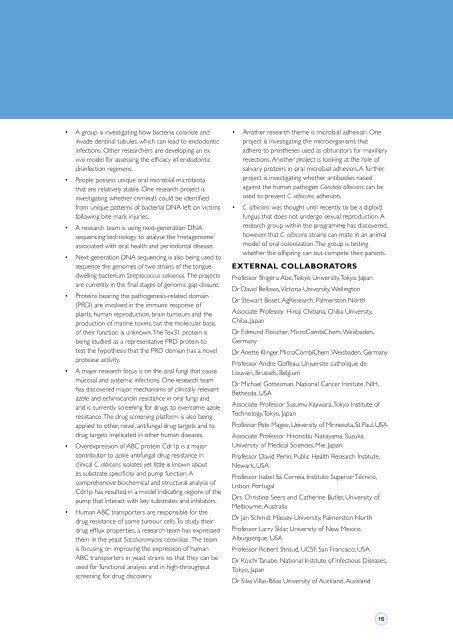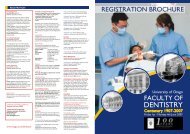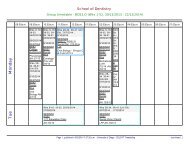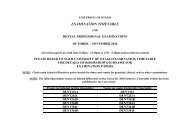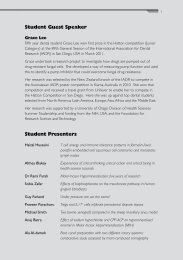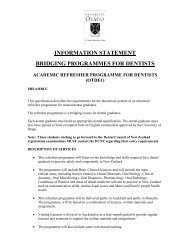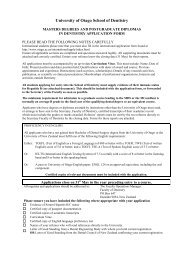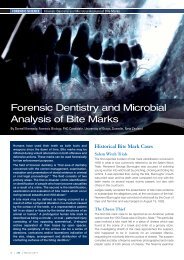2OO9 – 2O1O - Faculty of Dentistry - University of Otago
2OO9 – 2O1O - Faculty of Dentistry - University of Otago
2OO9 – 2O1O - Faculty of Dentistry - University of Otago
Create successful ePaper yourself
Turn your PDF publications into a flip-book with our unique Google optimized e-Paper software.
• A group is investigating how bacteria colonize and<br />
invade dentinal tubules, which can lead to endodontic<br />
infections. Other researchers are developing an ex<br />
vivo model for assessing the efficacy <strong>of</strong> endodontic<br />
disinfection regimens.<br />
• People possess unique oral microbial microbiota<br />
that are relatively stable. One research project is<br />
investigating whether criminals could be identified<br />
from unique patterns <strong>of</strong> bacterial DNA left on victims<br />
following bite mark injuries.<br />
• A research team is using next-generation DNA<br />
sequencing technology to analyse the ‘metagenome’<br />
associated with oral health and periodontal disease.<br />
• Next-generation DNA sequencing is also being used to<br />
sequence the genomes <strong>of</strong> two strains <strong>of</strong> the tonguedwelling<br />
bacterium Streptococcus salivarius. The projects<br />
are currently in the final stages <strong>of</strong> genomic gap closure.<br />
• Proteins bearing the pathogenesis-related domain<br />
(PRD) are involved in the immune response <strong>of</strong><br />
plants, human reproduction, brain tumours and the<br />
production <strong>of</strong> marine toxins, but the molecular basis<br />
<strong>of</strong> their function is unknown. The Tex31 protein is<br />
being studied as a representative PRD protein to<br />
test the hypothesis that the PRD domain has a novel<br />
protease activity.<br />
• A major research focus is on the oral fungi that cause<br />
mucosal and systemic infections. One research team<br />
has discovered major mechanisms <strong>of</strong> clinically relevant<br />
azole and echinocandin resistance in oral fungi and<br />
and is currently screening for drugs to overcome azole<br />
resistance. The drug screening platform is also being<br />
applied to other, novel, antifungal drug targets and to<br />
drug targets implicated in other human diseases.<br />
• Overexpression <strong>of</strong> ABC protein Cdr1p is a major<br />
contributor to azole antifungal drug resistance in<br />
clinical C. albicans isolates yet little is known about<br />
its substrate specificity and pump function. A<br />
comprehensive biochemical and structural analysis <strong>of</strong><br />
Cdr1p has resulted in a model indicating regions <strong>of</strong> the<br />
pump that interact with key substrates and inhibitors.<br />
• Human ABC transporters are responsible for the<br />
drug resistance <strong>of</strong> some tumour cells. To study their<br />
drug efflux properties, a research team has expressed<br />
them in the yeast Saccharomyces cerevisiae. The team<br />
is focusing on improving the expression <strong>of</strong> human<br />
ABC transporters in yeast strains so that they can be<br />
used for functional analysis and in high-throughput<br />
screening for drug discovery.<br />
• Another research theme is microbial adhesion. One<br />
project is investigating the microorganisms that<br />
adhere to prostheses used as obturators for maxillary<br />
resections. Another project is looking at the role <strong>of</strong><br />
salivary proteins in oral microbial adhesion. A further<br />
project is investigating whether antibodies raised<br />
against the human pathogen Candida albicans can be<br />
used to prevent C. albicans adhesion.<br />
• C. albicans was thought until recently to be a diploid<br />
fungus that does not undergo sexual reproduction. A<br />
research group within the programme has discovered,<br />
however, that C. albicans strains can mate in an animal<br />
model <strong>of</strong> oral colonization. The group is testing<br />
whether the <strong>of</strong>fspring can out-compete their parents.<br />
EXTERNAL COLLABORATORS<br />
Pr<strong>of</strong>essor Shigeru Abe, Teikyo <strong>University</strong>, Tokyo, Japan<br />
Dr David Bellows, Victoria <strong>University</strong>, Wellington<br />
Dr Stewart Bisset, AgResearch, Palmerston North<br />
Associate Pr<strong>of</strong>essor Hiroji Chibana, Chiba <strong>University</strong>,<br />
Chiba, Japan<br />
Dr Edmund Fleischer, MicroCombiChem, Weisbaden,<br />
Germany<br />
Dr Anette Klinger, MicroCombiChem, Weisbaden, Germany<br />
Pr<strong>of</strong>essor Andre G<strong>of</strong>feau, Universite catholique de<br />
Louvain, Brussels, Belgium<br />
Dr Michael Gottesman, National Cancer Institute, NIH,<br />
Bethesda, USA<br />
Associate Pr<strong>of</strong>essor Susumu Kajiwara, Tokyo Institute <strong>of</strong><br />
Technology, Tokyo, Japan<br />
Pr<strong>of</strong>essor Pete Magee, <strong>University</strong> <strong>of</strong> Minnesota, St Paul, USA<br />
Associate Pr<strong>of</strong>essor Hironobu Nakayama, Suzuka<br />
<strong>University</strong> <strong>of</strong> Medical Sciences, Mie, Japan.<br />
Pr<strong>of</strong>essor David Perlin, Public Health Research Institute,<br />
Newark, USA<br />
Pr<strong>of</strong>essor Isabel Sá Correia, Instituto Superior Técnico,<br />
Lisbon, Portugal<br />
Drs. Christine Seers and Catherine Butler, <strong>University</strong> <strong>of</strong><br />
Melbourne, Australia<br />
Dr Jan Schmid, Massey <strong>University</strong>, Palmerston North<br />
Pr<strong>of</strong>essor Larry Sklar, <strong>University</strong> <strong>of</strong> New Mexico,<br />
Albuquerque, USA<br />
Pr<strong>of</strong>essor Robert Stroud, UCSF, San Francisco, USA<br />
Dr Koichi Tanabe, National Institute <strong>of</strong> Infectious Diseases,<br />
Tokyo, Japan<br />
Dr Silas Villas-Bôas <strong>University</strong> <strong>of</strong> Auckland, Auckland<br />
15


